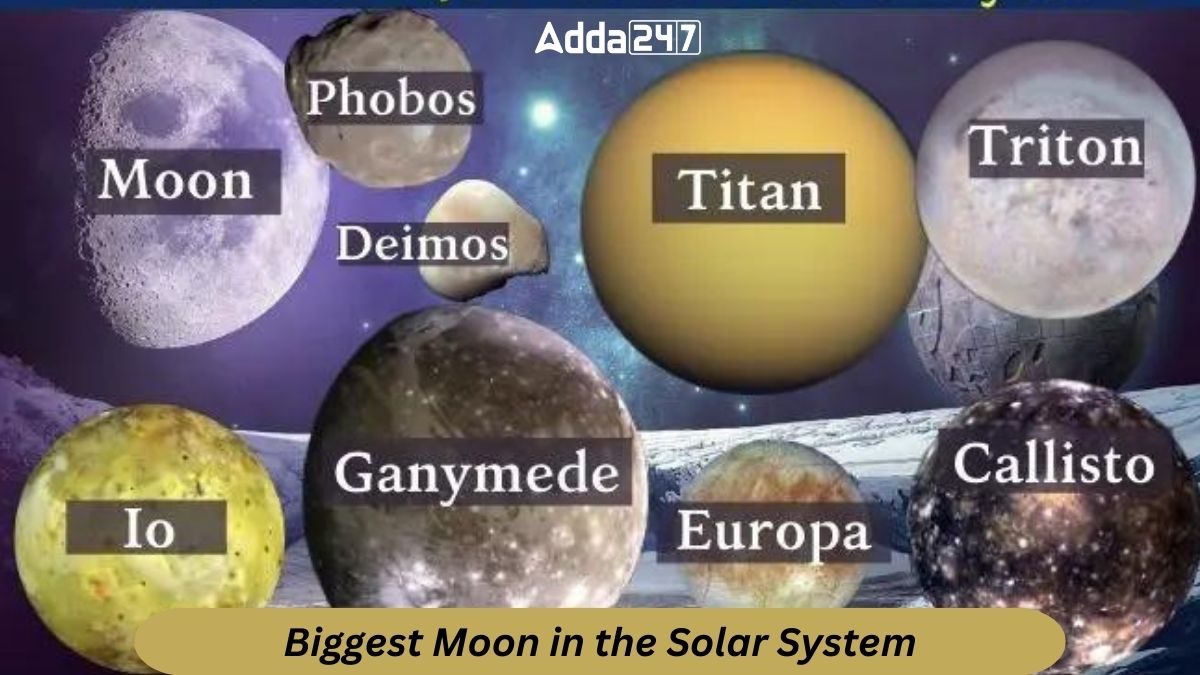Our solar system is home to a diverse array of celestial bodies, and among them are moons of varying sizes. Some of these moons are truly colossal, dwarfing their counterparts with their impressive dimensions. In this article, we’ll embark on a journey to uncover the top 10 largest moons in our solar system, each with its unique features and characteristics.
Largest Moon in the Solar System
Ganymede, Jupiter’s largest moon, holds the distinguished title of being the biggest moon in our solar system, surpassing even the sizes of Mercury and Pluto. With a diameter measuring 3,274 miles, Ganymede’s substantial dimensions qualify it as a planetary contender. Comprising three layers—a metallic core, a rocky shell, and an icy surface—this celestial giant emits its magnetic field, a unique feature among moons. Responsible for dazzling auroras at its poles akin to Earth’s Northern Lights, Ganymede’s discovery in 1610 was attributed to both Galileo and German astronomer Simon Marius, with Galileo’s publication securing historical credit.
Top-10 Biggest Moons in the Solar System
Ganymede, with the diameter of 3,274 miles, claims the title of the biggest moon in the solar system, followed by Oberon, Rhea, and Titania.
Here is the list of top-10 biggest moons in the solar system:
| LARGEST MOONS IN THE SOLAR SYSTEM | |||||
| S. No. | Moons | Orbit | Diameter | Year Discovered | Discovered by |
| 1. | Ganymede | Jupiter | 3,274 miles | 1610 | Galileo |
| 2. | Oberon | Uranus | 196 miles | 1787 | Sir William Herschel |
| 3. | Rhea | Saturn | 949 miles | 1672 | Giovanni Cassini |
| 4. | Titania | Uranus | 980 miles | 1787 | Herschel |
| 5. | Triton | Neptune | 1680 miles | 1846 | William Lassell |
| 6. | Europa | Jupiter | 1,940 miles | 1610 | Galileo Galilei |
| 7. | The Moon | Earth | 2,159 miles | Pre-historical Age | Unknown |
| 8. | Io | Jupiter | 2,264 miles | 1610 | Galileo |
| 9. | Callisto | Jupiter | 2,995 miles | 1610 | Galileo |
| 10. | Titan | 1610 | 3,200 miles | 1655 | Christiaan Huygens |
Biggest Moon in the Solar System – Ganymede
Orbit: Jupiter
Diameter: 3,274 miles
Year Discovered: 1610
Discovered By: Galileo
Ganymede, the largest moon in our solar system, boasts dimensions substantial enough to rival planets such as Mercury and Pluto. With three distinct layers—comprising a metallic core, a rock shell, and an icy surface—Ganymede emulates planetary characteristics. Notably, its metallic core induces the generation of a unique magnetic field, rendering it the sole moon in our solar system with this capability. This magnetic influence results in the captivating display of auroras at both its northern and southern poles, reminiscent of Earth’s mesmerizing Aurora Borealis.
Second Biggest Moon of our Solar System – Oberon
Orbit: Uranus
Diameter: 196 miles
Year Discovered: 1787
Discovered by: Sir William Herschel
As the second largest moon in our solar system, Titan, Saturn’s largest moon, boasts a complete atmosphere akin to a planet, featuring a liquid surface. Unlike Earth, Titan’s liquid is composed of methane and ethane, rendering its atmosphere inhospitable to terrestrial life. Despite being the only celestial body beyond Earth with a stable liquid surface, Titan’s harsh conditions, characterized by extreme cold, make it currently unsuitable for the evolution of life. Scientists, however, speculate that Titan’s present state resembles Earth’s conditions before the emergence of land masses, adding an intriguing dimension to our understanding of celestial bodies.
Third Largest Satellite in the Solar System – Rhea
Orbit: Saturn
Diameter: 949 miles
Year Discovered: 1672
Discovered by: Giovanni Cassini
Regarded initially as Jupiter’s unremarkable icy sphere, Callisto gained significance following evidence from the Galileo probe hinting at a potential subsurface saltwater ocean. This discovery sparked speculation about the potential evolution of life, akin to theories surrounding Europa. However, conclusive evidence remains elusive. Despite these tantalizing prospects, Callisto is an average celestial body, with dimensions approximately 2.5 times smaller than Earth, nearly matching the size of Mercury. These unique characteristics contribute to the ongoing exploration and intrigue surrounding Callisto, the third largest moon in our solar system.




 What was the Old Name of Bihar? Know Abo...
What was the Old Name of Bihar? Know Abo...
 Which River is known as the Diamond Rive...
Which River is known as the Diamond Rive...
 Which Dry Fruits are known as the King o...
Which Dry Fruits are known as the King o...







